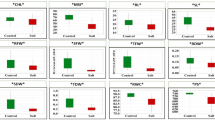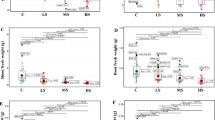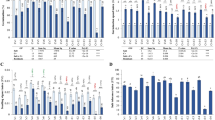Abstract
Salt stress is one of the significant abiotic constraints for wheat production globally. Crop improvement by exploiting wheat germplasm resources for salt tolerance is a very crucial mitigation strategy. In this study, pre-breeding resources of 284 wheat lines were screened for salt tolerance based on multivariate analysis. It was conducted in the control and naturally salt-affected conditions for 2 successive years (2018–2019 and 2019–2020). The selected evaluated traits were germination percentage (GP), tiller number (TN), days to flowering (DTF), days to maturity (DTM), grain filling duration (GFD), plant height (PH), spike length (SL), spikelet per spike (SPS), spike weight (SW) and grain yield (GY). The screening was based on the salt tolerance index (STI), salt susceptibility index (SSI), hierarchical cluster analysis, principal component analysis (PCA), and PCA-based ranking of the salt-tolerant cluster.These wheat lines were categorized into four categories; salt-tolerant (46 lines), moderately salt-tolerant (99), moderately salt-sensitive (100), and salt-sensitive (39). Wheat lines with high yield performance along with other important traits under optimum and stressed conditions maintained high values of each attribute. SW, SL, TN, PH, and GP have a high impact on GY based on the PCA results. The specific ranking of the salt-tolerant cluster lines signifies the potential of a single tolerant line has been established. LTP lines 187, 211, 161, 220, 211, 210, and 73 identified tolerant wheat lines are recommended for wheat improvement. The favorable adaptive traits will be instrumental in the wheat breeding program for salinity tolerance.




Similar content being viewed by others
Data availability
The actual contributions explained in the study are included in the manuscript/ supplementary data, further queries can be directed to sole author/s.
Abbreviations
- GP:
-
Germination percentage
- TN:
-
Tiller number
- DTF:
-
Days to flowering
- DTM:
-
Days to maturity
- GFD:
-
Grain filling duration
- PH:
-
Plant height
- SL:
-
Spike length
- SPS:
-
Spikelet per spike
- SW:
-
Spike weight
- GY:
-
Grain yield
- STI:
-
Salt tolerance index
- SSI:
-
Salt susceptibility index
- PCA:
-
Principal component analysis
- PBG:
-
Department of Plant Breeding and Genetics
- PAU:
-
Punjab Agricultural University
- LTP:
-
Linked Top cross population
- EC:
-
Electrical conductivity
- Ys:
-
Mean of trait under stressed condition
- Yp:
-
Mean of trait under non stressed condition
- SI:
-
Stress intensity
- Ŷs:
-
Mean of all wheat lines under stress condition
- Ŷp:
-
Mean of all wheat lines under non stress condition
- ANOVA:
-
Analysis of variance
- PCs:
-
Principal components
- Tmax:
-
Maximum temperature
- Tmin:
-
Minimum temperature
- RHmax:
-
Maximum relative humidity
- RHmin:
-
Minimum relative humidity
- ST:
-
Salt tolerant
- MST:
-
Moderately salt tolerant
- MSS:
-
Moderately salt sensitive
- SS:
-
Salt sensitive
- DF:
-
Degree of freedom
References
Abbas G, Saqib M, Rafique Q, Rahman AU, Akhtar J, Haq MA, Nasim M (2013) Effect of salinity on grain yield and grain quality of wheat (Triticum aestivum L.). Pak J Bot 50:185–189
Afzal M, Hindawi SE, Alghamdi SS, Migdadi HH, Khan MA, Hasnain MU, Arslan M, Habib ur Rahman M, Sohaib M (2023) Potential breeding strategies for improving salt tolerance in crop plants. J Plant Grow Reg 42:3365–3387. https://doi.org/10.1007/s00344-022-10797-w
Ahmad M, Shahzad A, Iqbal M, Asif M, Hirani AH (2013) Morphological and molecular genetic variation in wheat for salinity tolerance at germination and early seedling stage. Aus J Crop Sci 7:66–74
Ahmad A, Aslam Z, Javed T, Hussain S, Raza A, Shabbir R, Mora-Poblete F, Saeed T, Zulfiqar F, Ali MM, Nawaz M (2022) Screening of wheat (Triticum aestivum L.) genotypes for drought tolerance through agronomic and physiological response. Agronomy 12: 287. https://doi.org/10.3390/agronomy12020287
Al-Ashkar I, Ibrahim A, Ghazy A, Attia K, Al-Ghamdi AA, Al-Dosary MA (2021) Assessing the correlations and selection criteria between different traits in wheat salt-tolerant genotypes. Saudi J Biol Sci 28:5414–5427. https://doi.org/10.1016/j.sjbs.2021.05.076
Ali A, Basra SM, Ahmad R, Wahid A (2009) Optimizing silicon application to improve salinity tolerance in wheat. Soil Environ 28:136–144
Altaf A, Zhu X, Zhu M, Quan M, Irshad S, Xu D, Aleem M, Zhang X, Gull S, Li F, Shah AZ (2021) Effects of environmental stresses (heat, salt, water logging) on grain yield and associated traits of wheat under application of sulfur-coated urea. Agronomy 11:2340. https://doi.org/10.3390/agronomy11112340
Arifuzzaman M, Barman S, Hayder S, Azad MA, Turin MT, Amzad MA, Masuda MS (2020) Screening of bread wheat (Triticum aestivum L.) genotypes under drought stress conditions using multivariate analysis. Cer Res Comm 48:301–308. https://doi.org/10.1007/s42976-020-00039-8
Arzani A, Ashraf M (2016) Smart engineering of genetic resources for enhanced salinity tolerance in crop plants. Critic Rev Plant Sci 35:146–189. https://doi.org/10.1080/07352689.2016.1245056
Asseng S, Ewert F, Martre P, Rötter RP, Lobell DB, Cammarano D, Kimball BA, Ottman MJ, Wall GW, White JW, Reynolds MP (2015) Rising temperatures reduce global wheat production. Nat Climate Change 5:143–147. https://doi.org/10.1038/nclimate2470
Basavaraj PS, Gireesh C, Bharamappanavara M, Manoj CA, Honnappa VG, Ajitha V, Senguttuvel P, Sundaram RM, Anantha MS (2021) Stress tolerance indices for the identification of low phosphorus tolerant introgression lines derived from Oryza rufipogon Griff. Plant Gen Res 19:328–338. https://doi.org/10.1017/S1479262121000381
Bui EN (2013) Soil salinity: a neglected factor in plant ecology and biogeography. J Arid Environ 92:14–25. https://doi.org/10.1016/j.jaridenv.2012.12.014
Choudhary A, Kumar A, Kaur N (2020) ROS and oxidative burst: Roots in plant development. Plant Divers 42:33–43. https://doi.org/10.1016/j.pld.2019.10.002
Choudhary A, Kaur N, Sharma A, Kumar A (2021) Evaluation and screening of elite wheat germplasm for salinity stress at the seedling phase. Physiol Plant 173:2207–2215. https://doi.org/10.1111/ppl.13571
Dadshani S, Sharma RC, Baum M, Ogbonnaya FC, Leon J, Ballvora A (2019) Multi-dimensional evaluation of response to salt stress in wheat. PLoS ONE 14:e0222659. https://doi.org/10.1371/journal.pone.0222659
Dehnavi AR, Zahedi M, Ludwiczak A, Cardenas Perez S, Piernik A (2020) Effect of salinity on seed germination and seedling development of sorghum (Sorghum bicolor (L.) Moench) genotypes. Agronomy 10: 859. https://doi.org/10.3390/agronomy10060859
Dodig D, Savić J, Kandić V, Zorić M, RADOVIĆ BV, Popović A, Quarrie S, (2016) Responses of wheat plants under post-anthesis stress induced by defoliation: I. Contribution of agro-physiological traits to grain yield. Exp Agric 52:203–223. https://doi.org/10.1017/S0014479715000034
Dugasa T, Bebie B, Tomer R, Barnabas J (2016) Effect of seed priming on salt tolerance of bread wheat (Triticum aestivum L.) varieties. J Sci Islamic Repub 6:139–153. https://doi.org/10.1002/pld3.497
El-Hendawy S, Elshafei A, Al-Suhaibani N, Alotabi M, Hassan W, Dewir YH, Abdella K (2019) Assessment of the salt tolerance of wheat genotypes during the germination stage based on germination ability parameters and associated SSR markers. J Plant Interact 14:151–163. https://doi.org/10.1080/17429145.2019.1603406
Fernandez GC (1993) “Effective selection criteria for assessing plant stress tolerance,” in Proceedings of the International Symposium on Adaptation of Vegetables and other Food Crops In temperature and Water Stress, ed. C. G. Kuo (Tainan: AVRDC Publication): 257–270. https://doi.org/10.22001/wvc.72511
Fischer R, Maurer R (1978) Drought resistance in spring wheat cultivars. I. Grain Yield Responses, Australian J Agricul Res 29:897–912. https://doi.org/10.1071/AR9780897
Ghosh B, Md NA, Gantait S (2016) Response of rice under salinity stress: a review update. Rice Res 4:167. https://doi.org/10.4172/2375-4338.1000167
Guo Z, Zhao Y, Röder MS, Reif JC, Ganal MW, Chen D, Schnurbusch T (2018) Manipulation and prediction of spike morphology traits for the improvement of grain yield in wheat. Sci Rep 8:1–10. https://doi.org/10.1038/s41598-018-31977-3
Hasan A, Hafiz HR, Siddiqui N, Khatun M, Islam R, Mamun AA (2015) Evaluation of wheat genotypes for salt tolerance based on some physiological traits. J Crop Sci Biotechnol 18:333–340. https://doi.org/10.1007/s12892-015-0064-2
Hasanuzzaman M, Raihan MR, Masud AA, Rahman K, Nowroz F, Rahman M, Nahar K, Fujita M (2021) Regulation of reactive oxygen species and antioxidant defense in plants under salinity. Int J Mol Sci 22:9326. https://doi.org/10.3390/ijms22179326
Hasanuzzaman M, Saha NR, Farabi S, Tahjib-Ul-Arif M, Yasmin S, Haque MS (2022) Screening of salt-tolerant wheat (Triticum aestivum L.) through morphological and molecular markers. Cer Res Comm 17:1–4. https://doi.org/10.1007/s42976-022-00278-x
Huang M, Chai L, Jiang D, Zhang M, Zhao Y, Huang Y (2019) Increasing aridity affects soil archaeal communities by mediating soil niches in semi-arid regions. Sci Total Environ 647:699–707. https://doi.org/10.1016/j.scitotenv.2018.07.305
Hussain N, Ghaffar A, Zafar ZU, Javed M, Shah KH, Noreen S, Manzoor H, Iqbal M, Hassan IF, Bano H, Gul HS (2021) Identification of novel source of salt tolerance in local bread wheat germplasm using morpho-physiological and biochemical attributes. Sci Rep 11:1–12. https://doi.org/10.1038/s41598-021-90280-w
Iqbal MA, Rahim J, Naeem W, Hassan S, Khattab Y, Sabagh A (2021) Rainfed winter wheat (Triticum aestivum L.) cultivars respond differently to integrated fertilization in Pakistan. Fresenius Environ Bull 30:3115–3121
Javid S, Bihamta M, Omidi M, Abbasi A, Alipour H (2023) Evaluation of genetic diversity for bread wheat cultivars and landraces in terms of germination under salinity stress. Iranian J Seed Sci Technol 12:28–47. https://doi.org/10.22092/ijsst.2022.358348.1429
Jiang C, Zu C, Lu D, Zheng Q, Shen J, Wang H, Li D (2017) Effect of exogenous selenium supply on photosynthesis, Na+ accumulation and antioxidative capacity of maize (Zea mays L.) under salinity stress. Sci Rep 7:1–14. https://doi.org/10.1038/srep42039
Kakar N, Jumaa SH, Redoña ED, Warburton ML, Reddy KR (2019) Evaluating rice for salinity using pot-culture provides a systematic tolerance assessment at the seedling stage. Rice 12:1–14. https://doi.org/10.1186/s12284-019-0317-7
Khalid MF, Huda S, Yong M, Li L, Li L, Chen ZH, Ahmed T (2023) Alleviation of drought and salt stress in vegetables: crop responses and mitigation strategies. Plant Grow Reg 99:177–194. https://doi.org/10.1007/s10725-022-00905-x
Kizilgeci F, Yildirim M, Islam MS, Ratnasekera D, Iqbal MA, Sabagh AE (2021) Normalized difference vegetation index and chlorophyll content for precision nitrogen management in durum wheat cultivars under semi-arid conditions. Sustainability 13:3725. https://doi.org/10.3390/su13073725
Kumawat KC, Sharma B, Nagpal S, Kumar A, Tiwari S, Nair RM (2023) Plant growth-promoting rhizobacteria: Salt stress alleviators to improve crop productivity for sustainable agriculture development. Front Plant Sci 13:1101862. https://doi.org/10.3389/fpls.2022.1101862
Liu X, Chen D, Yang T, Huang F, Fu S, Li L (2020) Changes in soil labile and recalcitrant carbon pools after land-use change in a semi-arid agro-pastoral ecotone in Central Asia. Ecol Indic 110:105925. https://doi.org/10.3390/su13073725
Mickelbart MV, Hasegawa PM, Bailey-Serres J (2015) Genetic mechanisms of abiotic stress tolerance that translate to crop yield stability. Nat Rev Gen 16:237–251. https://doi.org/10.1038/nrg3901
Munns R, Husain S, Rivelli AR, James RA, Condon AG, Lindsay MP, Lagudah ES, Schachtman DP, Hare RA (2002) Avenues for increasing salt tolerance of crops, and the role of physiologically based selection traits. In Progress in plant nutrition: plenary lectures of the XIV international plant nutrition colloquium. Springer, Dordrecht. pp. 93–105. https://doi.org/10.1007/978-94-017-2789-1_7
Munns R, James RA (2003) Screening methods for salinity tolerance: a case study with tetraploid wheat. Plant Soil 253:201–218. https://doi.org/10.1023/A:1024553303144
Munns R, Tester M (2008) Mechanisms of salinity tolerance. Ann Rev Plant Biol 59:651–681. https://doi.org/10.1146/annurev.arplant.59.032607.092911
Mwadzingeni L, Shimelis H, Tesfay S, Tsilo TJ (2016) Screening of bread wheat genotypes for drought tolerance using phenotypic and proline analyses. Front Plant Sci 7:1276. https://doi.org/10.3389/fpls.2016.01276
Nassar RM, Kamel HA, Ghoniem AE, Alarcón JJ, Sekara A, Ulrichs C, Abdelhamid MT (2020) Physiological and anatomical mechanisms in wheat to cope with salt stress induced by seawater. Plants 9:237. https://doi.org/10.3390/plants9020237
Omrani S, Arzani A, Esmaeilzadeh Moghaddam M, Mahlooji M (2022) Genetic analysis of salinity tolerance in wheat (Triticum aestivum L). Plos one 17:e0265520. https://doi.org/10.1371/journal.pone.0265520
Otu H, Celiktas V, Duzenli S, Hossain A, El Sabagh A (2018) Germination and early seedling growth of five durum wheat cultivars (Triticum durum Desf.) is affected by different levels of salinity. Fresenius Environ Bull 27:7746–7757
Qin H, Li Y, Huang R (2020) Advances and challenges in the breeding of salt-tolerant rice. Int J Mol Sci 21:8385. https://doi.org/10.3390/ijms21218385
EL Sabagh A, Hossain A, Barutçular C, Iqbal MA, Islam MS, Fahad S, Sytar O, Çiğ F, Meena RS, Erman M (2020) Consequences of salinity stress on the quality of crops and its mitigation strategies for sustainable crop production: an outlook of arid and semi-arid regions. In Environment, climate, plant and vegetation growth. Springer, Cham. pp. 503–533. https://doi.org/10.1007/978-3-030-49732-3_20
Sareen S, Sharma P, Tiwari V, Sharma I (2014) Identifying wheat landraces as genetic resources for drought and heat tolerance. Res Crops 15:846–851. https://doi.org/10.5958/2348-7542.2014.01421.1
Sarkar RD (2023Jan) Kalita MC (2023) Alleviation of salt stress complications in plants by nanoparticles and the associated mechanisms: An overview. Plant Stress 24:100134. https://doi.org/10.1016/j.stress.2023.100134
Singh S, Sengar R, Kulshreshtha N, Datta D, Tomar RS, Rao V (2014) Assessment of multiple tolerance indices for salinity stress in bread wheat (Triticum aestivum L.). J Agric Sci 7:49–57. https://doi.org/10.5539/JAS.V7N3P49
Singh S, Vikram P, Sansaloni C, Pixley K (2016) Global Challenges and Urgency for Partnerships to Deploy Genetic Resources. Indian J Genet Plant Breed 29:351–353. https://doi.org/10.5958/0976-1926.2016.00066.8
Slafer GA, Savin R, Sadras VO (2014) Coarse and fine regulation of wheat yield components in response to genotype and environment. Field Crops Res 157:71–83. https://doi.org/10.1016/j.fcr.2013.12.004
Sorour SG, Aiad MA, Ahmed AA, Henash MIA, Metwaly EM, Alharby H, Bamagoos A, Barutçular C (2019) Yield of wheat is increased through improving the chemical properties, nutrient availability and water productivity of salt affected soils in the north delta of Egypt. Appl Ecol Environ Res 17:8291–8306. https://doi.org/10.15666/aeer/1704_82918306
Suzuki K, Yamaji N, Costa A, Okuma E, Kobayashi NI, Kashiwagi T, Katsuhara M, Wang C, Tanoi K, Murata Y, Schroeder JI (2016) OsHKT1; 4-mediated Na+ transport in stems contributes to Na+ exclusion from leaf blades of rice at the reproductive growth stage upon salt stress. BMC Plant Biol 16:22. https://doi.org/10.1186/s12870-016-0709-4
Wu H, Guo J, Wang C, Li K, Zhang X, Yang Z, Li M, Wang B (2019) An effective screening method and a reliable screening trait for salt tolerance of Brassica napus at the germination stage. Front Plant Sci 10:530. https://doi.org/10.3389/fpls.2019.00530
Zhao S, Zhang Q, Liu M, Zhou H, Ma C, Wang P (2021) Regulation of plant responses to salt stress. Int J Mol Sci 22:4609. https://doi.org/10.3390/ijms22094609
Zhu X, Chang G, He D, Zhao H, Ma C (2014) Evaluation of new onion varieties using cluster analysis and principal component analysis methods. Gansu Agr Sci 10:25–38
Acknowledgements
The research work was supported by the Council of scientific and industrial research (CSIR) New Delhi, India
Funding
There is no funding source for the work.
Author information
Authors and Affiliations
Contributions
The primary draft of the paper was designed by Anuj choudhary, Achla sharma, Antul kumar, Nirmaljit kaur and Harmanjot kaur help in the establishment of script. Nirmaljit Kaur and Antul Kumar reviewed the content and well approved by Harmanjot Kaur, Antul Kumar, and Achla Sharma. Antul Kumar and Nirmaljit Kaur examined the final draft and actively engaged in prepared the table and figure and section. The statistical tools applied by Anuj Choudhary, on data and well supported by Nirmaljit Kaur, Harmanjot Kaur, Antul Kumar. Additionally Antul Kumar, Nirmaljit Kaur and Harmanjot Kaur examined the manuscript at each phase of manuscript writing and offered crucial advice. All authors carefully observed the content and approved the submitted version of the paper.
Corresponding authors
Ethics declarations
Competing interest
The authors declare that they have no conflict of interest.
Ethical approval
Not applicable.
Informed consent
Not applicable.
Additional information
Publisher's Note
Springer Nature remains neutral with regard to jurisdictional claims in published maps and institutional affiliations.
Rights and permissions
Springer Nature or its licensor (e.g. a society or other partner) holds exclusive rights to this article under a publishing agreement with the author(s) or other rightsholder(s); author self-archiving of the accepted manuscript version of this article is solely governed by the terms of such publishing agreement and applicable law.
About this article
Cite this article
Choudhary, A., Kaur, N., Sharma, A. et al. Screening and Assessment of Triticum aestivum Germplasm for Salt Tolerance in Naturally affected Conditions. J Soil Sci Plant Nutr (2024). https://doi.org/10.1007/s42729-024-01676-2
Received:
Accepted:
Published:
DOI: https://doi.org/10.1007/s42729-024-01676-2




